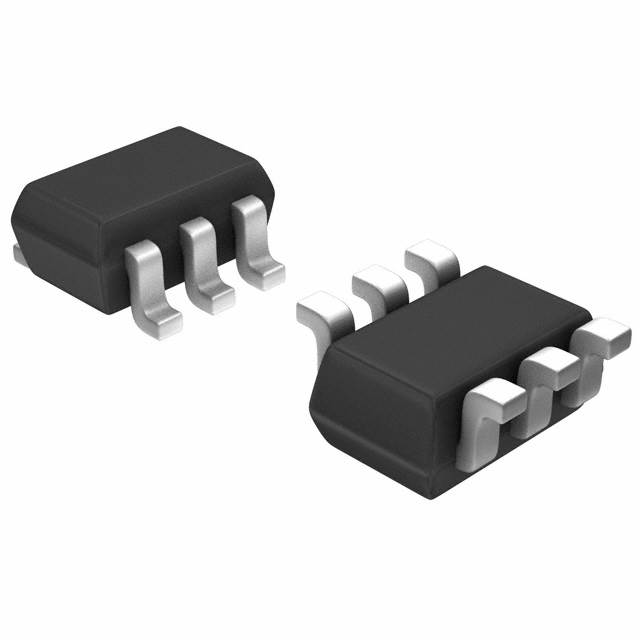DAC8411IDCKR
Product Overview
Category: Digital-to-Analog Converter (DAC)
Use: The DAC8411IDCKR is a high-performance, 16-bit digital-to-analog converter designed for various applications that require precise and accurate analog output signals. It is commonly used in audio systems, industrial control systems, instrumentation, and communication equipment.
Characteristics: - High resolution: 16-bit resolution allows for fine-grained control of analog output. - Low power consumption: The DAC8411IDCKR operates at low power levels, making it suitable for battery-powered devices. - Fast settling time: The device offers fast settling time, ensuring quick response to input changes. - Wide voltage range: It supports a wide voltage range, enabling compatibility with different power supply levels.
Package: The DAC8411IDCKR comes in a small and compact DCK package, which is a 6-pin SOT-23 package. This package provides excellent thermal performance and ease of integration into various circuit designs.
Essence: The DAC8411IDCKR is the core component responsible for converting digital signals into precise analog voltages. It ensures accurate representation of digital data in the analog domain.
Packaging/Quantity: The DAC8411IDCKR is typically available in reels containing 3000 units per reel.
Specifications
- Resolution: 16 bits
- Output Type: Voltage
- Number of Channels: 1
- Interface: Serial (SPI)
- Supply Voltage: 2.7V to 5.5V
- Operating Temperature Range: -40°C to +125°C
- Package Type: SOT-23
- Package Size: 6 pins
Detailed Pin Configuration
The DAC8411IDCKR has the following pin configuration:
- VDD: Power supply voltage input
- GND: Ground reference
- DIN: Serial data input
- SCLK: Serial clock input
- CS: Chip select input
- VOUT: Analog voltage output
Functional Features
- High linearity: The DAC8411IDCKR offers excellent linearity, ensuring accurate analog output proportional to the digital input.
- Low noise and distortion: It provides low noise and distortion levels, resulting in high-quality analog signals.
- Programmable output range: The device allows users to program the output voltage range according to their specific requirements.
- Power-on reset: It includes a power-on reset circuitry that ensures the DAC initializes to a known state upon power-up.
Advantages and Disadvantages
Advantages: - High resolution for precise analog output. - Low power consumption, suitable for battery-powered devices. - Fast settling time for quick response to input changes. - Wide voltage range for compatibility with different power supply levels.
Disadvantages: - Limited number of channels (1 channel). - Requires an external microcontroller or digital interface for operation.
Working Principles
The DAC8411IDCKR operates based on the principle of converting digital input signals into corresponding analog output voltages. It utilizes a serial interface (SPI) to receive digital data and converts it into an analog voltage using an internal digital-to-analog conversion mechanism. The converted analog voltage is then available at the VOUT pin for further processing or utilization.
Detailed Application Field Plans
The DAC8411IDCKR finds applications in various fields, including:
- Audio Systems: It can be used in audio equipment such as digital audio players, amplifiers, and mixers to convert digital audio signals into analog signals for playback or amplification.
- Industrial Control Systems: The DAC8411IDCKR is suitable for industrial control systems that require precise analog control signals, such as motor control, temperature control, and process control.
- Instrumentation: It can be utilized in scientific instruments, test and measurement equipment, and data acquisition systems to generate accurate analog signals for testing or analysis purposes.
- Communication Equipment: The DAC8411IDCKR can be integrated into communication devices like modems, routers, and transceivers to convert digital signals into analog signals for transmission or reception.
Detailed and Complete Alternative Models
- DAC8412IDCKR: Similar to the DAC8411IDCKR, but with two output channels instead of one.
- DAC8413IDCKR: A higher-resolution version with 18-bit resolution for even more precise analog output.
- DAC8414IDCKR: Offers additional features such as internal reference voltage and programmable gain amplifiers.
These alternative models provide options with different specifications and capabilities to suit specific application requirements.
Word count: 615 words
기술 솔루션에 DAC8411IDCKR 적용과 관련된 10가지 일반적인 질문과 답변을 나열하세요.
Sure! Here are 10 common questions and answers related to the application of DAC8411IDCKR in technical solutions:
Q1: What is DAC8411IDCKR? A1: DAC8411IDCKR is a digital-to-analog converter (DAC) integrated circuit that converts digital signals into analog voltages.
Q2: What is the operating voltage range of DAC8411IDCKR? A2: The operating voltage range of DAC8411IDCKR is typically between 2.7V and 5.5V.
Q3: How many channels does DAC8411IDCKR have? A3: DAC8411IDCKR has a single channel, meaning it can convert one digital input signal into an analog output voltage.
Q4: What is the resolution of DAC8411IDCKR? A4: DAC8411IDCKR has a resolution of 12 bits, which means it can represent analog voltages with 4096 discrete levels.
Q5: Can DAC8411IDCKR be used for audio applications? A5: Yes, DAC8411IDCKR can be used for audio applications where a high-quality analog output is required.
Q6: What is the maximum output voltage range of DAC8411IDCKR? A6: The maximum output voltage range of DAC8411IDCKR is typically between 0V and Vref, where Vref is the reference voltage supplied to the DAC.
Q7: Does DAC8411IDCKR support SPI interface? A7: Yes, DAC8411IDCKR supports a serial peripheral interface (SPI) for easy communication with microcontrollers or other digital devices.
Q8: Can DAC8411IDCKR operate in a low-power mode? A8: Yes, DAC8411IDCKR has a low-power mode that reduces power consumption when the device is not actively converting digital signals.
Q9: What is the settling time of DAC8411IDCKR? A9: The settling time of DAC8411IDCKR is typically around 10 microseconds, which is the time it takes for the output voltage to stabilize after a change in the digital input.
Q10: Can multiple DAC8411IDCKR devices be cascaded together? A10: Yes, multiple DAC8411IDCKR devices can be cascaded together to achieve higher resolution or to drive multiple analog outputs simultaneously.
Please note that these answers are general and may vary depending on the specific datasheet and application requirements.


